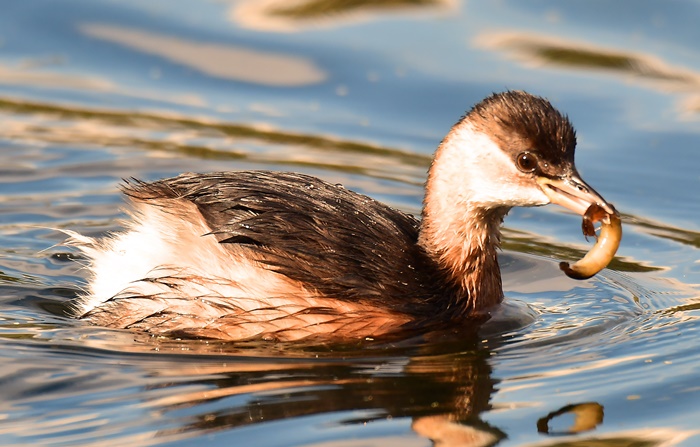I was going through my past archive of all the birds and animals I’ve written about for the GA Advertiser over the past few years, and was surprised to find I’d missed out on one of the easiest birds to be found in the Clot – the Little Grebe, which you are almost certain to see if you are visiting the main pool, at any time of the year.
The smallest of the grebes, the Little Grebe, (which is also known in the UK as the Dabchick) is considerably rounder and more dumpy than its larger relatives, the absence of a tail and its habit of fluffing-up feathers at the rear end making it look a bit like a miniature dinghy.
Little Grebes are persistent divers, either slipping below without surface disturbance or with a vigorous jump, creating a shower with their lobed feet. Dives may last up to half a minute, when you can watch the bubbles the birds make as they hunt their prey, or the birds may reappear immediately. If alarmed, a Little Grebe will submerge until only its head remains above water.
At times there is fierce rivalry, with the male Little Grebes chasing each other at high speed with necks extended, water-kicking, splash-diving and skidding across the water followed by underwater attacks. In full combat, rivals rise breast to breast in vertical posture, attacking with feet and stabbing with bills. Courtship may continue on moonlit nights, when you can also hear their trilling calls quite clearly.
My picture shows a juvenile bird, with lighter colouration than the adults which are mostly dark brown, almost looking black at times, with chestnut markings on the head. There are several of these juveniles about at the moment, so you may see more in this colouration than the adult birds for the next few months. It appears to have caught some sort of larva species, they also catch fish and other small invertebrates.
In the next three or four months, they will make their nests deep within the reeds out of vegetation which is mostly collected from underwater – they may make three or four nests before choosing the best one.
They are very successful birds here in Spain – any open stretch of water is likely to contain a few of them, and you might also find them in irrigation ditches in farmland areas. Their breeding range extends right across central and southern Europe as far north as southern Sweden and the Baltic States. Birds on the northern fringe, where there is regular winter freezing of rivers and lakes, need to migrate southward each autumn, but our birds are strictly resident. You are unlikely to see them on land, as with feet set well back on their bodies they are more or less unable to walk!
You can see more photographs of birds from our area by visiting www.marketheridge.smugmug.com
See you next month.



